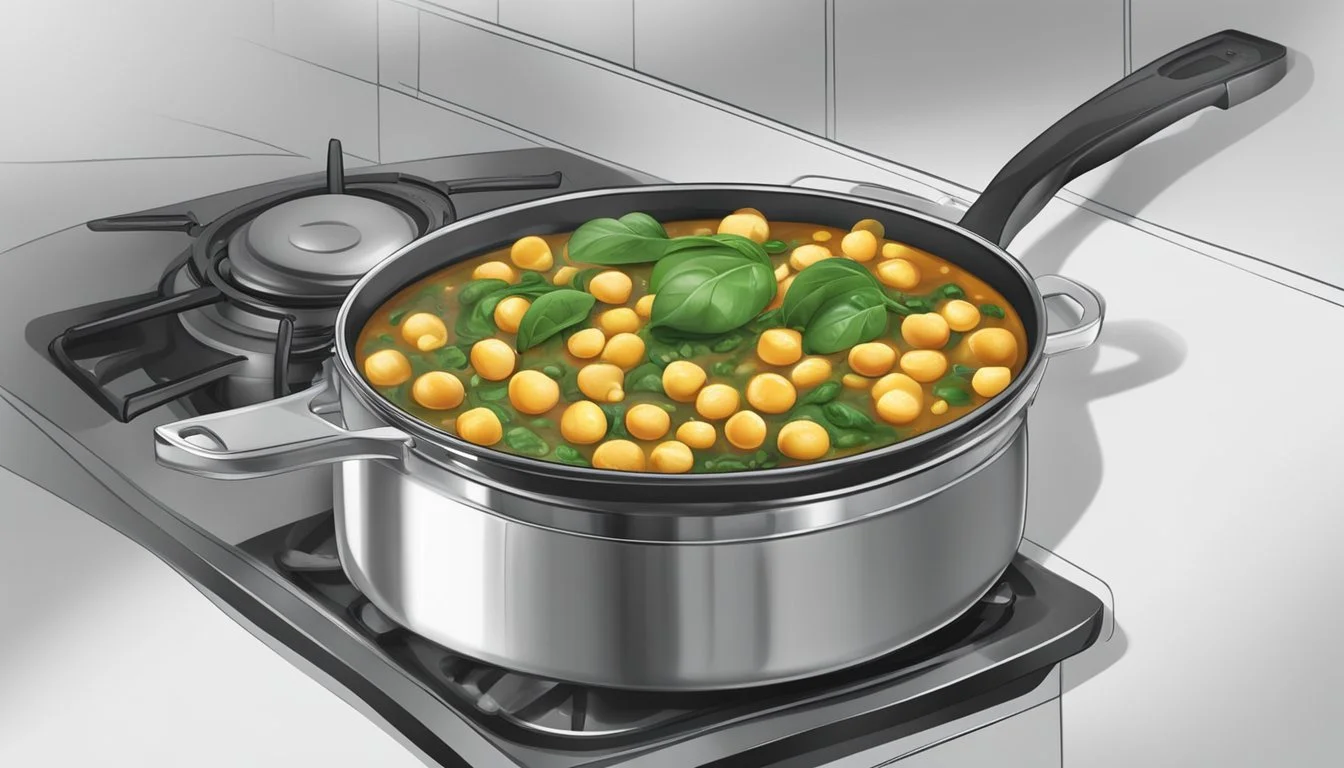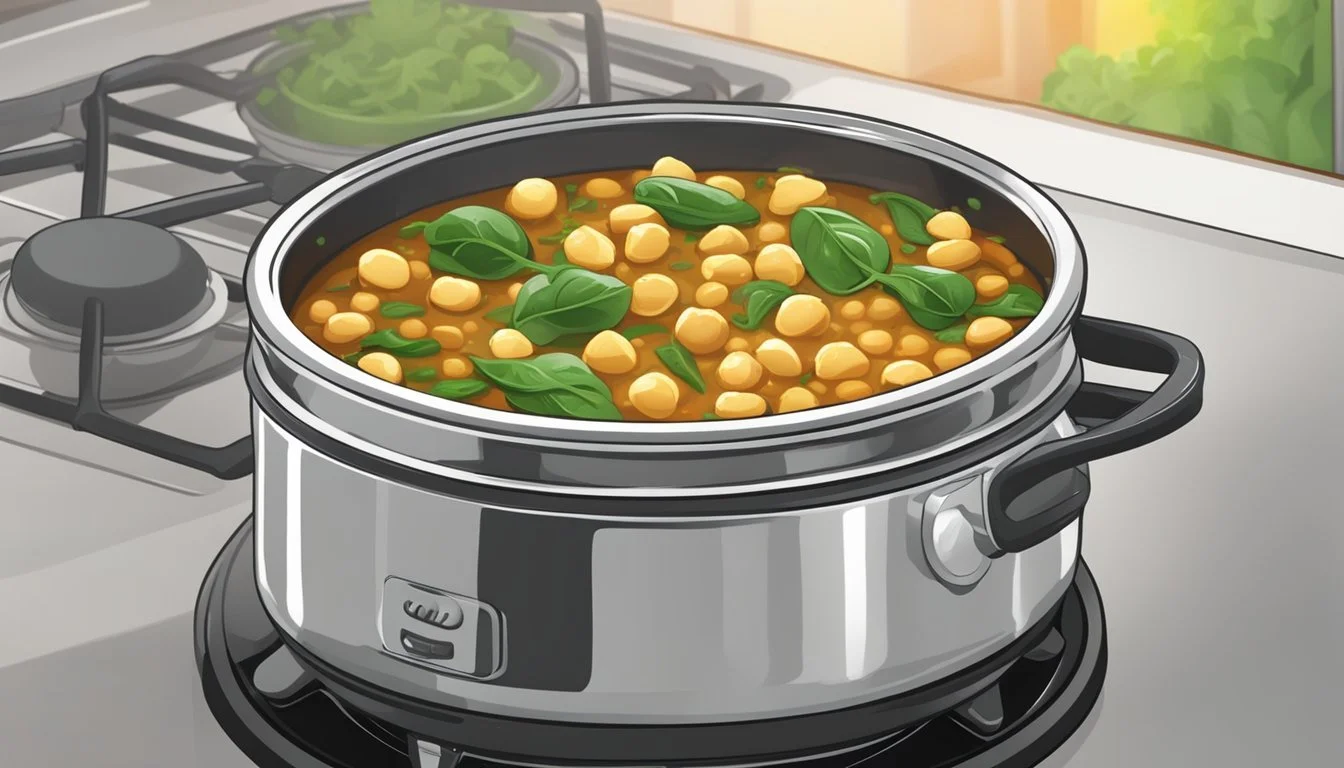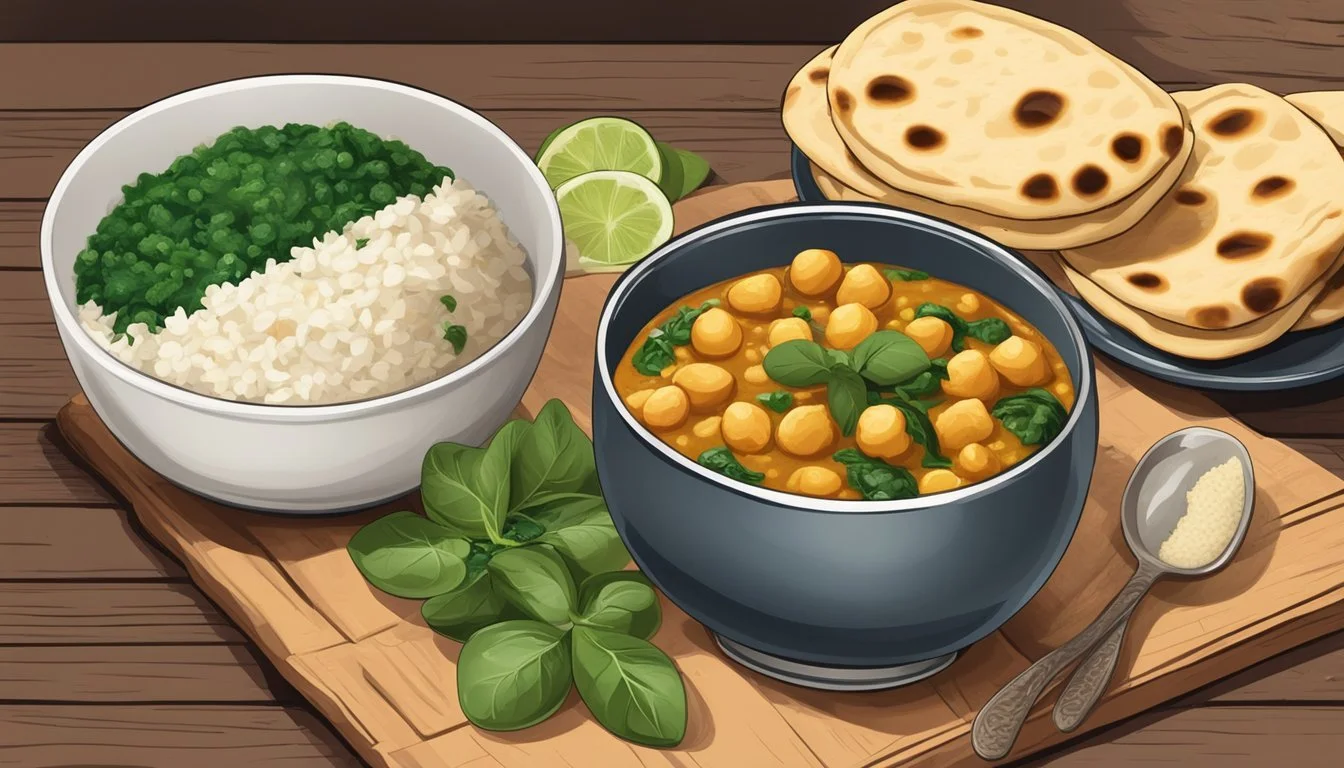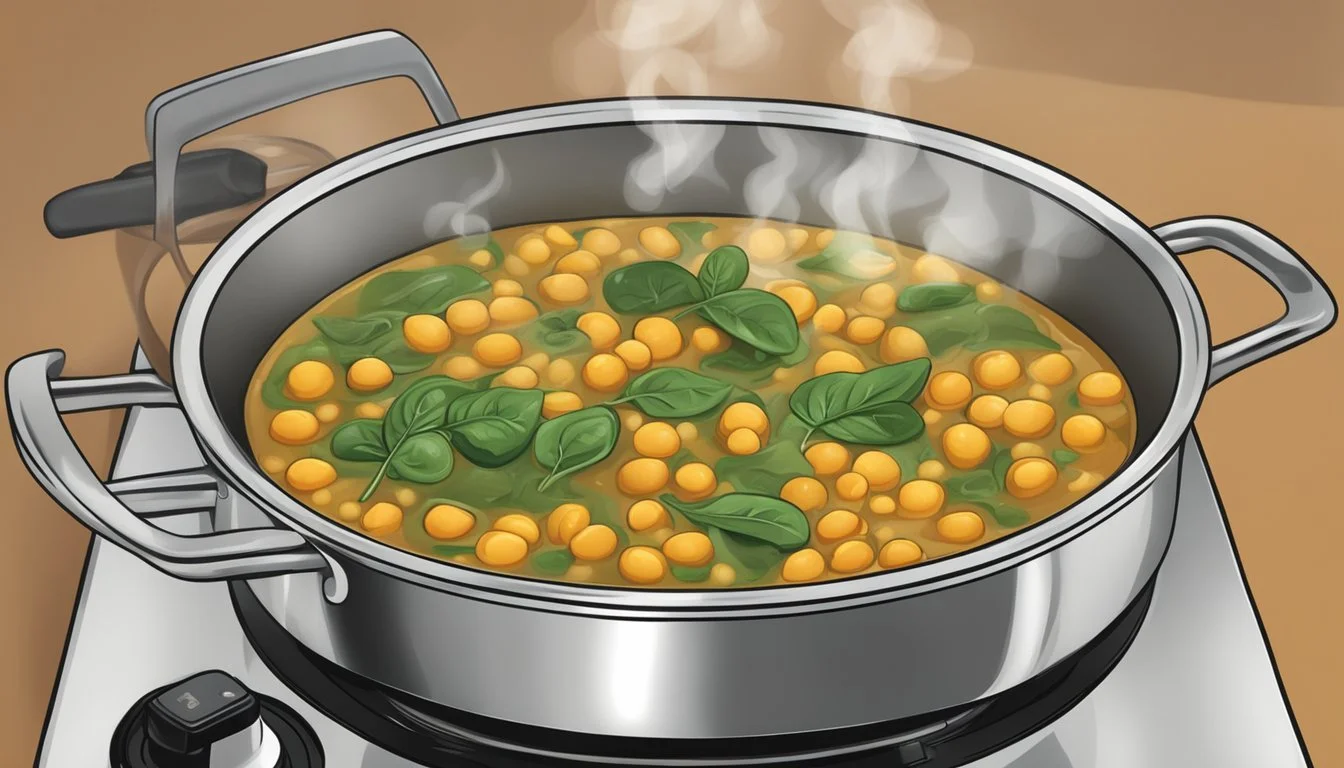How to Reheat Chickpea and Spinach Curry for Perfect Texture and Flavor
Reheating chickpea and spinach curry can often lead to a loss of texture and flavor if not done correctly. To reheat the curry in the microwave, transfer it to a microwave-safe dish, cover loosely, and add a tablespoon of water to maintain moisture. Heat it at a medium temperature in short increments of 30 seconds, stirring in between to ensure even heat distribution.
Using a stovetop method is an excellent alternative for those who prefer a slower, more controlled reheating process. Place the curry in a saucepan over medium heat, stirring occasionally to prevent scorching. Adding a bit of water or coconut milk can help achieve a consistency similar to its original state.
Oven reheating is another method, particularly effective for larger portions. Preheat the oven to 350°F (175°C), transfer the curry to an oven-safe dish, cover with foil, and bake until heated through. This approach allows the curry to reheat evenly while retaining its robust flavor and hearty texture.
Overview of Chickpea and Spinach Curry
Chickpea and spinach curry combines nutritious ingredients and rich flavors for a satisfying, healthy, and vegan meal option. This dish features chickpeas and spinach as its main components, offering a balance of protein, fiber, and essential vitamins.
Understanding the Base Ingredients
Chickpea and spinach curry primarily uses chickpeas and spinach. Chickpeas, also known as garbanzo beans, are legumes that provide a good source of plant-based protein and are high in fiber. This makes them ideal for a vegan diet.
Spinach is another crucial ingredient, offering a wealth of nutrients, including iron, vitamins A and C, and antioxidants. Spinach’s mild flavor helps balance the robustness of the chickpeas, making them excellent companions in a curry.
Coconut milk is often used as a base, lending the curry a creamy texture and a slight sweetness that complements the savory spices. Other common ingredients include tomatoes, garlic, and a variety of spices like turmeric and curry powder, all of which contribute to the depth of flavor.
Benefits of Chickpeas and Spinach
Chickpeas are renowned for their health benefits. They are packed with protein essential for muscle repair and growth, making them a staple in many vegan dishes. Their high fiber content aids in digestion and helps maintain healthy blood sugar levels.
Spinach is equally beneficial, providing an excellent source of iron, which is crucial for oxygen transport in the body. The rich array of vitamins and minerals in spinach contributes to overall health, supporting everything from immune function to skin health.
Together, chickpeas and spinach make a powerful nutritional duo in this curry, ensuring a meal that is both hearty and health-promoting. This combination supports a balanced diet and meets various dietary needs, particularly for those following a vegan lifestyle.
Preparation Before Reheating
Proper preparation ensures that chickpea and spinach curry retains its flavors and texture when reheated. Key steps include storing leftovers correctly and thawing frozen curry for optimal results.
Storing Chickpea and Spinach Curry
To keep leftovers fresh, use airtight containers. Transfer the curry into these containers as soon as it cools to room temperature.
Store the curry in the refrigerator for up to 3-4 days. Label the container with the date to track freshness. For longer storage, place the airtight containers in the freezer, where the curry can last up to 2-3 months.
Avoid storing hot curry directly in the refrigerator or freezer, as this can raise the temperature inside and affect other stored items.
Thawing Frozen Curry
Before reheating, thaw frozen chickpea and spinach curry in the refrigerator overnight. This slow thawing helps maintain the curry's texture and ensures even reheating.
If time is short, the curry can be thawed using the microwave's defrost setting. Use a microwave-safe dish and regularly check to avoid partially cooked spots.
Avoid leaving the curry out at room temperature to thaw, which can promote bacterial growth and compromise safety.
Reheating Techniques
Reheating chickpea and spinach curry is straightforward and can be done using a microwave, stovetop, or oven. Each method has its benefits, such as maintaining moisture or ensuring even heat distribution.
Using a Microwave
For a quick and easy method, the microwave is ideal. Transfer the curry to a microwave-safe dish and cover it loosely. This helps keep the moisture in while preventing splatters.
Add a tablespoon of water to maintain moisture. Heat the curry at a medium temperature in 30-second increments. Stir the curry between each interval to ensure even warming. Repeat the process until the curry reaches the desired temperature.
Heating on the Stovetop
Using the stovetop is another effective way to reheat curry. Place the curry in a saucepan over medium-low heat. Stir frequently to prevent sticking and to distribute the heat evenly. If the curry appears too thick, add a small amount of water or stock.
Cover the pan with a lid to trap the steam, helping to reheat the curry thoroughly. Stir every couple of minutes until the curry is piping hot.
Warming in an Oven
To reheat curry in the oven, preheat the oven to 350°F (175°C). Spoon the curry into an oven-safe dish and cover it with foil to prevent drying out. Adding a small amount of water or stock can help maintain the curry's consistency.
Place the dish in the oven and heat for 15-20 minutes. Check and stir the curry occasionally to ensure it’s heating evenly. Once hot, it’s ready to be served.
Maintaining Flavor and Texture
Ensuring that the delicious flavors and textures of chickpea and spinach curry remain intact is crucial when reheating this dish. Properly reheating while making slight adjustments can preserve its quality.
Adding Freshness to Leftovers
When reheating chickpea and spinach curry, consider adding a few fresh ingredients to revitalize the dish. Fresh garlic and onions can enhance the aroma and depth of flavor. If the curry initially used fresh ginger, adding a small amount can restore its original zing.
Lime juice squeezed over the reheated curry can add a fresh, tangy note. This acidity balances the creaminess of the coconut milk. Freshly chopped cilantro can also provide a burst of color and freshness. Use these additions sparingly, allowing the original flavors to shine through.
Adjusting Spices and Seasonings
As curry flavors may mellow over time, reheating is an ideal opportunity to adjust spices and seasonings. Turmeric, cumin, and garam masala are core spices that can be lightly added during reheating for a flavor boost. Be cautious with garam masala as it can overpower if overused.
Salt and pepper can be adjusted to taste, especially if new vegetables or ingredients have been added. If the curry has become too thick, a splash of coconut milk or vegetable broth can restore its desirable creaminess. Ensuring the spice level meets preferences will keep the dish as enjoyable as when it was first made.
Serving Suggestions
Chickpea and spinach curry pairs wonderfully with a variety of accompaniments and can be presented beautifully to enhance your dining experience. Here are some tips to make your meal even more enjoyable.
Choosing the Right Accompaniments
When serving chickpea and spinach curry, consider staples like basmati rice or naan bread. Basmati rice, with its fragrant aroma and fluffy texture, complements the rich curry sauce perfectly. For those seeking a healthier option, brown rice or quinoa can be excellent alternatives.
Naan bread is another popular choice, providing a delicious way to scoop up the curry. For added variety, you might include sweet potatoes roasted with a dash of cumin and chili. These bring a subtle sweetness and additional texture to the meal.
Feel free to offer a simple cucumber raita as a side, as its cool, creamy texture is a great contrast to the spicy curry. Mixed vegetable pickles can also add tanginess and a crunchy element to your plate.
Plating and Presentation Tips
To create an appealing presentation, start by placing a serving of basmati rice or another grain in the center of the plate. Arrange the chickpea and spinach curry around the rice, letting some of the sauce naturally mix in.
Add a piece of naan on the side, either folded or torn into pieces for easy scooping. Garnish the curry with fresh cilantro leaves and a wedge of lime to add color and a burst of freshness.
Using contrasting colors can make the dish more visually appealing. For instance, serve the curry in a vibrant bowl or plate, and use simple cloth napkins that complement the dish's colors. Adding a small dish of cucumber raita to the side can further enhance the visual and culinary experience.
Consider setting the table with some fresh flowers or candles to elevate the dining experience and make it feel special.
Optimizing Nutrition and Dietary Needs
Tailoring the recipe to specific dietary restrictions ensures that everyone can enjoy chickpea and spinach curry while meeting their nutrition goals.
Tailoring the Recipe to Dietary Restrictions
Gluten-Free: Chickpea and spinach curry is naturally gluten-free. Ensure all spices and any additional ingredients, such as soy sauce, are certified gluten-free to avoid gluten contamination.
Vegetarian: This curry is ideal for vegetarians by using chickpeas and spinach as primary ingredients. Select vegetable broth instead of chicken broth to keep it entirely plant-based.
Vegan: To make the curry vegan, avoid using any animal-derived products. Check for hidden animal products in pre-packaged ingredients and opt for coconut milk instead of dairy-based cream.
Calories and Nutrients: Adjust the recipe to control calories and enhance nutrient intake. Reduce the amount of coconut milk for a lower-calorie version. Add more spinach for increased vitamins and minerals, and include a variety of vegetables such as bell peppers for additional nutrients.
Recipe Variations and Substitutions
Exploring different ingredients and alternative cooking methods can add unique flavors and textures to chickpea and spinach curry. These changes can make the dish more suited to personal tastes or dietary preferences.
Experimenting with Different Ingredients
Incorporating different veggies like potatoes or cauliflower can add variety. Kale or other leafy greens can be used instead of spinach for a different texture and nutritional profile.
Adjusting the level of cayenne or adding fresh curry powder can change the spice level. Coconut milk is often used for a creamy texture, but substituting it with almond milk or soy milk can cater to different dietary needs.
Alternative Cooking Methods
Instead of the stovetop, a slow cooker can be used. Combine chickpeas, spinach, and other ingredients, and cook on low for 4-6 hours.
Using a pressure cooker can reduce cooking time significantly. Simply cook all ingredients under high pressure for about 15 minutes.
A microwave can be used for reheating, following these steps:
Transfer to a microwave-safe dish.
Add a tablespoon of water to maintain moisture.
Heat in short increments of 30 seconds, stirring in between.
Different cooking methods can yield various textures and flavors, offering flexibility for busy schedules or different preferences.
Tips for Meal Prep and Bulk Cooking
Effective meal prep and bulk cooking for chickpea and spinach curry involve several strategies to save time and ensure freshness. These include efficient cooking methods and proper storage techniques to maintain flavor and quality.
Efficient Cooking and Storage Strategies
When batch cooking chickpea and spinach curry, consider pre-cooking ingredients separately. For instance, cook chickpeas and chop spinach in advance. This separates preparation tasks and speeds up the final cooking process.
Store cooked curry in meal-sized portions. Use airtight containers to keep servings fresh and ready to reheat. Label each container with the date to track freshness.
Additionally, keep an organized pantry with essential spices like cumin, coriander, and garam masala. Having these pantry staples at hand makes preparing large quantities easier.
For optimal reheating, use the microwave or stovetop. Ensure even heating by stirring periodically and adding a splash of water if needed to maintain moisture. This preserves the dish's texture and taste, making it time-saving and filling for future meals.
Engagement and Community
Engaging with a community of fellow food enthusiasts can help you share and discover new ways to enjoy your favorite recipes. Social media platforms offer various avenues for interaction, feedback, and inspiration.
Sharing Your Curry Creations
Sharing your chickpea and spinach curry creations on Instagram or Pinterest can inspire others and generate engagement. Use hashtags like #vegancurry or #homemadecurry to reach a wider audience.
Posting step-by-step processes and finished dishes can spark comments and interactions from followers who may try the recipe themselves.
On Facebook, joining cooking groups focused on vegan recipes allows you to share your experiences and get tips from others. Encourage your friends and followers to give the curry a star rating when they try it.
This feedback can help you perfect your recipe and build a supportive community.
Online cooking courses can also be a great place to share your creations and get valuable feedback. Courses often have forums or discussion boards where participants share and critique each other's work.
Engaging in these discussions can provide new techniques and ideas to enhance your meals.






